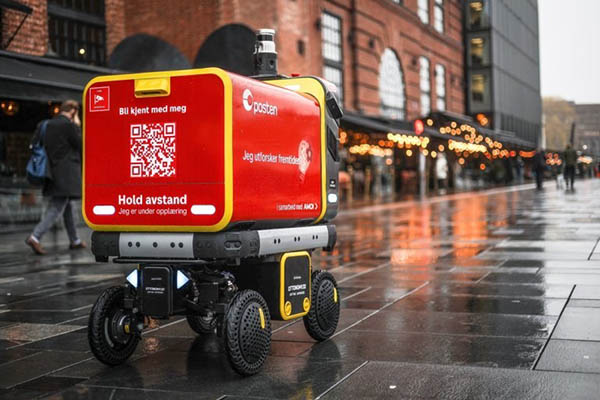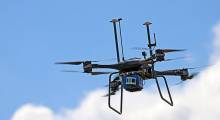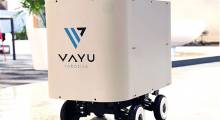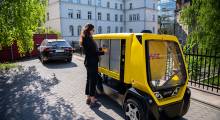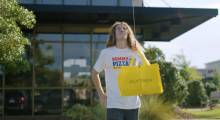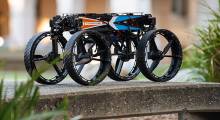Last-mile delivery gets a lot of attention for automation, but what about other links in the supply chain? Ottonomy Inc. is applying robots to multiple stages and is working with partners to grow its global presence.
The Santa Monica, Calif.-based company has developed mobile robots that can work both indoors and outdoors. After starting with the Cincinnati/Northern Kentucky International Airport (CVG) last year, Ottobot rolled out at CES. Ottonomy later demonstrated its robotics-as-a-service (RaaS) offering at AUVSI Xponential.
In addition, Ottonomy this month said it is collaborating with Posten Norge AS and Holo for “first-mile” autonomous deliveries for intralogistics pickups in Norway. Robotics 24/7 spoke with Ritukar Vijay, co-founder and CEO of Ottonomy, about the company's approach to rapidly scaling up its fleet.
Ottonomy identifies a problem to solve
How is first-mile delivery a pain point in logistics?
Vijay: Last-mile deliveries of products to end customers is important, but there are already vans doing that. The real pain point for any postal and logistics player is feeding items from the source to the hub to consolidate for delivery.
It was very evident to Posten that’s the problem we wanted to solve. For pickup, it had to send vans, which had to park illegally because there's no space. The company is already good at delivery; pickup was where it needed help.
It's helpful if robots can transition from indoors to outdoors, where vans are already parked. It's very helpful that Ottobot can come to the consolidation area so people don't have to go out. That way, there are minimum touch points to the packages and maximum operational efficiency.
How does this compare with last-mile automation?
Vijay: In due course, the delivery process in general can be automated, with connections to micro-fulfillment centers or long last-mile deliveries. Last-mile delivery is still exciting to solve—and we're doing it with customers right now—but the core problem of first mile is important to customers and helps with scale.
We're not tied down to first mile or last mile. For us, the technology is the same. This use case is real and has its own challenges, such as transitions between indoors and outdoors.
Gatik is attempting to go fully autonomous for the middle mile, and Nuro is going for local deliveries, despite recent setbacks. We have to choose our battles, and each company is honing its technology to a specific area.
Ottobot operates in snow, as well as indoors
What is Ottonomy learning from its tests in Norway?
Vijay: Oslo is one of the best testbeds for autonomous vehicles, and relatively few companies are testing there. Posten Group is one of the largest, oldest postal services in Europe.
We're testing Ottobot's robustness in different weather. Our robots are delivering every day in the Oslo environs, even during rain and mild snowfall.
We're looking for the best “sweet spot” for the remote operator to take over versus where even teleoperation won't work, such as heavier snow. That's managed by local partners.
Speaking of partners, when is teleoperation necessary?
Vijay: For large fleet deployments at Level 4 autonomy, certain scenarios fall back to the teleoperation option. That safety net, and also maintenance and support in that particular geography, are where partners such as integrator Holo come in.
We're looking for very competent partners that understand the domain and value proposition. It's good to have broad monitoring. If there are 100 robots at a particular location and one is asking for help, it should be attended to in real time.
We want to make sure that uptime is high for the customer and the people working around the robots.
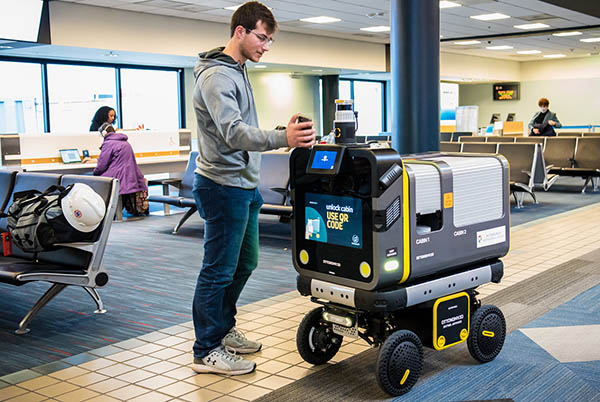
Fleet management and RaaS
How much does Ottonomy rely on fleet management software?
Vijay: We don't 100% monitor robots at all times, just when they're in specific zones, such as crossings. Teleoperation is required if there are no traffic signals.
We're trying to make our software more intuitive so that the robot-to-person ratio increases. It's 1:5 or 1:10 right now. We want to make it more natural for any team to actually manage 500 robots.
This is happening on the software and cloud side, but the autonomy piece has to continuously improve. We're working hand in hand with the people managing fleets. If 95 out of 100 robots are in autonomous mode, we go down to those last five whose autonomous health is not so good.
The intuitive behavior coming from robots to fleet managers is super-critical.
How does the RaaS model help with scaling?
Viyay: That service model is not going away, and it's a change of pace for a business. RaaS is good for go-to-market strategy, but at the same time, there's the possibility of hybrid models. We want to give customers options—from full RaaS to hardware and software, or partly capex [capital expenditures] and software as a service [SaaS].
These models are more attractive to customers because of a more reasonable service fee. Or, you could have more capex or opex [operating expenses], which gives us and customers some flexibility.
Since Ottobot 2.0 launched in August, we've had 10 to 12 new customers, so there are more learnings to go on which is better for each. People love RaaS, but customers are also realizing they want the “stickiness” of a service model but want to get rid of some capex right away.
Simultaneous deployments prepare for future growth
In August, Ottonomy closed a $3.3 million seed round. How is your global expansion going?
Vijay: There's always the battle for startups between spreading oneself too thin and going to market too early. Building a customer base gives us a way to learn as fast as possible what market is growing and how.
For example, if you're in one market, you may then have to wait for a later quarter to enter another. Because we've engaged customers at the same time globally, as we scale, we can serve whichever customers are ready.
If the European market is bad, we can go to North America or the Middle East. Europe has actually been amazing in terms of reception of new technologies, and so much is happening around automation in North America because of high labor costs.
Last week, Ottonomy announced that it is working with the Pittsburgh International Airport for a pilot project offering contactless delivery to select passengers. We now have installations at three airports globally.
You mentioned certain regions, but what about India?
Vijay: Our robots are manufactured in Noida, India, but we're not focusing on that market unless it solves a customer's problems right away. A lot of people come to us, and the potential scale of outbound/inbound movement is massive.
However, labor costs are still reasonable there, and while e-commerce demand is high, it's not there yet for last-mile delivery.
What are some of your goals for 2023?
Vijay: We started 2022 with one customer, CVG. In 2023, it will be about multiplying our robots with customers that were involved with two to 10 robots to larger volumes. We're working with them to make it happen.
At the same time, business development will go crazy for the company to keep growing. Before, we had no outdoor deployments to show. Now, we can show that if a customer has a genuine problem, we can help solve it.
We work with each customer to create a viability matrix to see what problems robots can solve. We're trying to engage with customers for the long term.
About the Author
Follow Robotics 24/7 on Linkedin
Article topics
Email Sign Up

